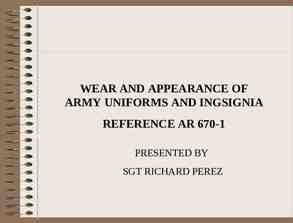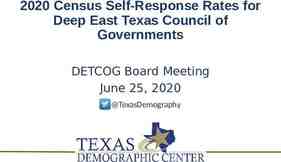In-Class Exercise: The Poisson Distribution 3-105. The number of
6 Slides57.50 KB
In-Class Exercise: The Poisson Distribution 3-105. The number of surface flaws in plastic panels used in the interior of automobiles has a Poisson distribution with a man of 0.05 flaws per square foot of plastic panel. Assume an automobile interior contains 10 square feet of plastic panel. a) What is the probability that there are no surface flaws in an auto’s interior? b) If 10 cars are sold to a rental car company, what is the probability that none of the 10 cars has any surface flaws? c) If 10 cars are sold to a rental car company, what is the probability that at 1
Solution: Part a Let X be the number of surface flaws in a car’s interior. Since there are an average of 0.05 flaws per square foot and a car interior contains of 10 square feet of the material, X is Poisson random variable with a mean of 0.5. P ( X 0) e 0.5 0.5 0! 0 e 0.5 0.6065. 2
Solution: Part b Let Y be the number of surface flaws in a fleet of 10 cars. Since there are an average of 0.05 flaws per square foot and one car interior contains of 10 square feet of the material, Y is Poisson random variable with a mean of 5. 5 e 5 P( X 0) 0! 0 e 5 0.0067. 3
Solution: Part b Let Z be the number of cars that have surface flaws in a fleet of 10 cars. In Part a we found that the probability that a car has no surface flaws is e-0.5. Therefore, the probability that a car has any surface flaws is (1-e-0.5) If we treat the fleet of cars as sequence of 10 Bernoulli trials, then Z is a binomial random variable with n 10 and p (1-e-0.5). 10 0.5 P ( Z 0) 1 e 0 0 0.5 10 e e 5 0.0067. 4
Solution: Part c Let Z be the number of cars that have surface flaws in a fleet of 10 cars. In part a we found that the probability that a car has no surface flaws is e-0.5. Therefore, the probability that a car has any surface flaws is (1-e-0.5) If we treat the fleet of cars as sequence of 10 Bernoulli trials, then Z is a binomial random variable with n 10 and p (1-e-0.5). P ( Z 1) P( Z 0) 10 1 e 0.5 0 0.0504. 0 0.5 10 e P( Z 1) 10 0.5 1 0.5 1 e e 1 9 5
Solution: Part c Notice that the random variable Y counts the number of surface flaws in 100 square feet of plastic panel. This is equivalent to 10 car interiors, however the event that there are say 6 surface flaws in 100 square feet of plastic panel can be realized in many different ways. For example – All 6 flaws are in the first 10 square feet (i.e., they are all in the first car) – 3 flaws are in the first 10 square feet, 2 flaws are in the second 10 square feet, and 1 is in the third 10 square feet (i.e., there are flaws in the first 3 cars). While it’s true that P(Y 0) P(Z 0), it is not true that P(Y x) P(Z x) for x 0. So, we must use the Binomial distribution for Part c. 6











